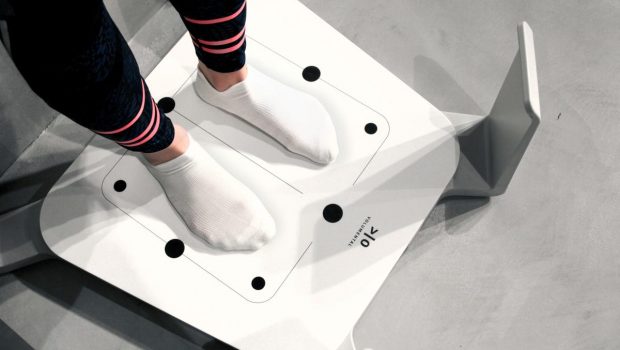Volumental’s FitTech Technology Makes Ill-Fitting Shoes A Thing Of The Past
A consumer scanning her feet using Volumental's FitTech technology.
Volumental is out to modernize the experience of buying footwear by helping customers find their exact shoe size and recommending appropriate shoes. Because footwear standards are wildly inconsistent, shoe returns are a big headache for the retail industry, with 44% of shoppers saying that they’ve returned footwear, and more than 70% returning shoes for improper fit. Volumental has helped its retail partners reduce returns by 20%, the company said.
Alper Aydemir, cofounder and CEO of Volumental, said the technology, called FitTech, matches consumers with perfectly-fitting shoes using computer vision, purchase data and AI, which has “learned” from 30 million 3D foot scans from clients including Under Armour
UAA
With a background in technology, including a Phd in Machine Learning and AI, Aydemir worked in the robotics department of NASA, and was part of Google’s
GOOG
“I guess my heart is in building products and scaling technology that can solve real world problems,” he said. “I find myself in the fashion, footwear industry. Im solving an important problem. Our vision is to shape a future where everybody exists and what we do is we match people to products that are going to fit them perfectly. We want to occupy that emotional space. Size is not a number, it’s a feeling. How it fits and how it makes you feel.”
“This is the future of retail,” Aydemir said. “The first use case is brick and mortar in stores. Within four seconds you can get a scan of your feet. Then we go into recommendations. When you include this in email marketing, it leads to double the amount of conversions.”
Volumental is now working to bring the experience to mobile phones. “It’s not a gimmick, you learn something about your body. Consumers open Volumental’s FitTech multiple times and use it online.”
Apparel is in Aydemir’s mind, but applying the Volumental technology to apparel isn’t imminent. “Product development is near and dear to us,” he said. “Some footwear companies based on the scans, have revamped their whole lines. If we reach those it’s going to be by manufacturing products that fit better. Instead of giving me the sixth color of the shoe, why don’t you create more width. Women need to go one size up and sometimes it doesn’t fit well.
“We’re driving the conversation with some of the largest brands in footwear,” Aydemir added. “We are currently only footwear, but we do want to tackle apparel. I’m a firm believer in get one thing done really well. I really want to do the footwear vertical well. We deliver a lot of value to a lot of people. We can take those lessons and apply them to apparel.
FitTech starts by scanning feet, collecting shape and size data from millions of people all over the world. This data base of 3D foot scans is matched to purchase data from FinTech by Volumental’s retail partners. Advanced algorithms crunch the numbers to produce size and style recommendations. Because shoppers have the opportunity to create a profile based on their 3D scans, they can be onboarded to loyalty programs and email campaigns quickly.
Alex Tollman director of retail experience at Fleet Feet, said 75% of the retailer’s customers are getting scanned when they visit stores. “Consumers are finding that their true shoe size is different than what they thought all along. We get that a lot. One of the most interesting things is that people don’t realize that they have wide feet. They’re used to wearing shoes that are too long for them so they get that extra width at the front of the shoe.
“After going through the scanning process, we show them that,” Tollman added. “They can wear shoes that are a better fit with a wide option so they’re not tripping over the ends of the shoes. One of the biggest insights we realized was that there is such an untapped opportunity in width, so we significantly increased what we offer in wide shoes.”
Headless commerce is an architecture, where the frontend layer, (the head,) is decoupled from the backend. It’s a simple, yet powerful approach that overcomes the problems of traditional solutions, where all components, from presentation to data base are tightly coupled into one single, monolithic platform. The headless data provides all functions and data via API (application program interface), that stay consistent across different sales channels and other customer touchpoints.
We give owners a wide lens of multiple retail- and restaurant tenant daily sales performances, neatly itemized on one dashboard. It’s like watching a stock channel, except clients see how their tenants perform. To do this, we integrate with multiple cloud-based POS systems, such as Shopify. It’s crucial that the retail real estate ecosystem focuses on consumer spending habits in real time now — whether online, omnichannel or any channel — to be reactive instead of just proactive. As a merchant, owner or lender, you need to know what’s happening in these channels.








Gloss